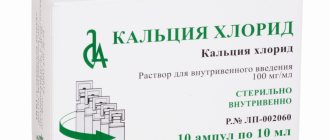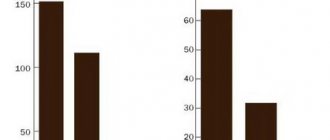Composition and price of sodium chloride
{banner_banstat0}
Sodium chloride solution, or saline, is a colorless, salty liquid that has no distinct odor. There are 2 types of saline solution with different concentrations of NaCl: 0.9% isotonic, and 10% hypertonic.
Composition of the product per 1 liter:
| Sodium chloride | Distilled water | |
| Isotonic solution | 9 g | 1 l |
| Hypertonic solution | 100 g |
There are several forms of saline solution:
- ampoules of 1, 5, 10, 20 ml;
- bottles of 50, 100, 200, 250, 400, 500, 100 ml;
- packages of 250, 500, 1000 ml.
Storage conditions for sodium chloride: store in a dry place, out of reach of children and pets, at a temperature of +18 to +25 degrees. The shelf life of the product is 5 years.
The cost of the solution depends on the form of release, volume and manufacturer. Average prices are:
- In ampoules: 30-325 rubles.
- In bottles and bags: 25-60 rubles.
- Hypertonic saline: 80-220 rubles.
The drug is dispensed from pharmacies according to the prescription of the attending physician.
Release form
A 0.9% sodium chloride solution is produced, which can be contained in ampoules of 5 ml, 10 ml, 20 ml. Ampoules are used to dissolve medications for injection.
A solution of sodium chloride 0.9% is also produced in bottles of 100, 200, 400 and 1000 ml. Their use in medicine is practiced for external use, intravenous drips, and enemas.
Sodium chloride solution 10% is contained in bottles of 200 and 400 ml.
For oral administration, tablets of 0.9 g are available.
A nasal spray is also produced in 10 ml bottles.
How is sodium chloride beneficial for the body?
{banner_banstat1}
Chlorinated sodium is present in the blood plasma and tissue fluids of the human body. It is responsible for the stability of the osmotic pressure of intercellular fluid and blood. When there is a shortage of this substance, water leaves the vascular bed and passes into the interstitial fluid.
This provokes the following conditions:
- increased blood density;
- spasms of smooth, skeletal muscles;
- neurological pathologies;
- disorders of the cardiovascular system.
Infusion of saline solution returns the water-salt balance to normal, and also cleanses the body of toxins and breakdown products formed as a result of the activity of harmful bacteria.
External use of NaCl improves the secretion of pus, restores microflora, and destroys pathogenic microorganisms of various origins.
In addition, chlorinated sodium improves the absorption of medications. Patients are often placed on a drip with intravenous medications diluted with saline.
special instructions
If an infusion is given, the patient's condition should be carefully monitored, in particular plasma electrolytes. It should be taken into account that in children, due to the immaturity of kidney function, sodium excretion . It is important to determine its plasma concentration before repeated infusions.
It is important to monitor the condition of the solution before administering it. The solution must be transparent and the packaging undamaged. Only a qualified specialist can use the solution for intravenous administration.
Any preparations with Sodium Chloride should only be dissolved by a specialist who can qualifiedly assess whether the resulting solution is suitable for administration. It is important to strictly adhere to all antiseptic rules. Any solution should be administered immediately after its preparation.
The result of a series of chemical reactions involving sodium chloride is the formation of chlorine. Electrolysis of molten Sodium Chloride in industry is a method of producing chlorine. If you carry out electrolysis of a solution of Sodium Chloride, you also end up with chlorine. If crystalline Sodium Chloride is treated with concentrated sulfuric acid, the result is hydrogen chloride . Sodium sulfate and sodium hydroxide can be produced through a chain of chemical reactions. Qualitative reaction to chloride ion - reaction with silver nitrate .
pharmachologic effect
{banner_banstat2}
Sodium chloride is used as a detoxification, rehydration and plasma replacement agent. Its use is accompanied by the following effects:
- normalization of water and salt balance;
- replenishment of Na and Cl deficiency;
- temporary increase in blood volume;
- increased urine output to cleanse the body.
Due to the improvement in the bioavailability of most drugs, saline solution is used in medicine as a means for diluting injection and infusion drugs.
It is incompatible or poorly compatible with the following medications:
- norepinephrine;
- corticosteroids;
- leukopoiesis stimulator Filgrastim;
- antibiotic Polymyxin B.
In case of arterial hypertension, sodium chloride should not be combined with Enapril and Spirapril: the use of saline solution reduces the hypotensive effect of these drugs.
The saline solution has an osmotic pressure similar to the human blood environment, and therefore is quickly eliminated from the body. Already 1 hour after using the dropper, less than half of the product remains in the body.
Sodium chloride for nasal rinsing. When to wash, contraindications
Saline solution for rinsing the nose of newborns is indicated in the following cases:
- The need to cleanse the nasal passages of dried crusts. They significantly complicate normal breathing, causing discomfort and lack of oxygen. For this reason, the child may refuse to eat; air will enter his stomach, causing belching and excessive regurgitation. Difficulty breathing can cause delayed psychomotor development, cause defects in the formation of facial bones, and chronic pathologies of the respiratory system. In such a situation, a saline solution relieves the baby of congestion, clears it and prevents complications from developing.
- Runny nose of any etiology. It can be caused by allergies, viruses or bacteria. Instillation of saline solution makes the child feel better, since he does not yet know how to blow his nose. Also, such moisturizing reduces irritation of the mucous membranes and helps flush the nasal cavity from pathogenic microorganisms. This prevents the infection from spreading to the larynx, trachea and beyond. But for rhinitis, saline solution is only an auxiliary medicine; it cannot be the main treatment.
- Preparing the nose for the administration of basic medications.
- Moisturizing the nasal mucosa after being in a smoky or dusty place.
- Prevention of infections. The saline solution washes away pathogenic microbes. This is very useful after the baby is in places with large crowds of people - shops, hospitals, clinics.
Why is saline solution prescribed?
Saline solution is administered intravenously in the form of infusions when indicated:
- Severe and critical dehydration of the body, disturbance of water-salt balance.
- Reduced plasma volume with large blood losses, dyspepsia, severe burns, diabetic coma.
- Carrying out surgical procedures, postoperative period.
- Intoxication of the body due to infections and poisonings of various origins.
- Epigastric, ileocecal, pulmonary bleeding.
- Digestive pathologies: nausea, vomiting, diarrhea, chronic and acute constipation.
- Lack of Na and Cl in the body.
When introducing droppers of saline solution with additional components, the list of indications expands.
Overdose
Sometimes, if used incorrectly, an overdose can occur.
Its symptoms:
- nausea;
- vomit;
- diarrhea;
- weakness;
- drowsiness;
- abdominal pain;
- renal failure;
- hypertension;
- convulsions;
- heartbeat;
- elevated temperature;
- increased sodium levels in the blood;
- acidosis.
In case of such phenomena, you should stop using the medicine and treat symptomatically.
Instructions for use for dropper
{banner_banstat3}
Before introducing sodium chloride inside, it must be heated to a temperature of 36-38 degrees. The dosage of the drug is calculated individually, based on the patient’s condition, medical history, age and weight.
The average daily dosage of the drug varies in the following values:
- Adults: 500-3000 ml.
- During pregnancy: 300-1200 ml.
- Children: 20-100 ml per kg of weight.
Important!
To instantly replenish the lack of Na and Cl, 100 ml is administered once. The average dropper speed is 540 ml/h. The hypertonic solution is injected in a stream.
For dilution and drip administration of other drugs, from 50 to 250 ml of physiological solution per dose of the drug is used.
How to use
This medicine is administered subcutaneously and intravenously. The dose is determined depending on the weight and age of the person. The average dose that can be administered during the day is five hundred milliliters. The dropper should be warmed up to 36-37 degrees.
If this is a child, then the dose is calculated as follows: twenty to one hundred milliliters per kilogram of weight.
They also do a rectal enema with a five percent saline solution in a volume of one hundred milliliters in order to induce bowel movements. It can also be administered to eliminate edema, reduce intracranial and blood pressure. Contraindications: inflammation and erosion of the rectum.
The wounds are washed with saline solution as prescribed by the surgeon. Compresses soaked in this medicine are also applied to the wounds. This promotes the drainage of pus and the death of harmful microbes.
The nose is washed with saline solution to treat and prevent sinusitis. Adults take two drops, children – one drop into each nostril. The course of treatment is twenty days.
Saline solution is used for inhalation, adding to the inhaler according to the instructions. You can carry out mixed inhalations by adding ambroxol to saline solution or other mucolytics. Inhalations are carried out up to three times a day for five to ten minutes.
You can prepare your own saline solution at home. To do this, add a teaspoon of salt to a liter of boiled water and stir. But such a solution cannot be used for intravenous administration.
Side effects
{banner_banstat4}
Rare negative effects that occur with prolonged or heavy use of sodium chloride include:
- In neurology: anxiety, severe headaches, dizziness, increased sweating, weakness, constant feeling of thirst.
- In gastroenterology: stomach cramps, diarrhea, nausea and vomiting.
- In gynecology: failures in the circulatory system, delays, dysmenorrhea.
- In cardiology: increased heart rate, arrhythmia, high blood pressure.
- In dermatology: dermatitis, acne.
- In hematology: anemia, hypokalemia.
- In endocrinology: increased acidity of the body, edema.
If such complications occur, the administration of saline solution is stopped, and the patient is given assistance to eliminate the side effects.
Analogs
Level 4 ATC code matches:
Calcium Chloride
Calcium chloride
Magnesium sulfate
Potassium chloride
Rheosorbilact
Reamberin
Different drug manufacturers may produce the solution under a separate name. These are the drugs Sodium chloride Brown , Sodium chloride Bufus , Rizosin , Salin Sodium chloride Sinco , etc.
Preparations containing sodium chloride are also produced. These are combined salt solutions of sodium acetate + sodium chloride, etc.
Contraindications for intravenous administration
Infusion of saline solution is prohibited for the following pathologies:
- swelling of the lungs and brain;
- pathologies of the kidneys and heart muscle;
- abundance of Na and Cl, lack of K in the body;
- extracellular hyperhydration;
- dehydration inside the cell;
- taking large doses of corticosteroid drugs.
A dropper with saline solution is a quick and effective way to replenish blood volume in the body, restore water-salt balance, and cleanse toxins. To prevent the product from causing a negative reaction, it should be used exclusively under the supervision of a physician.
Indications for use
Sodium chloride is a saline solution that is used when the body loses extracellular fluid. Indicated for conditions that lead to limited fluid intake:
- dyspepsia due to poisoning;
- vomiting , diarrhea ;
- cholera;
- extensive burns;
- hyponatremia or hypochloremia , in which dehydration is noted.
Considering what sodium chloride is, it is used externally to wash wounds, eyes, and nose. The drug is used to moisturize dressings, for inhalation, and for the face.
The use of NaCl is indicated for forced diuresis in cases of constipation , poisoning, and internal bleeding (pulmonary, intestinal, gastric).
It is also indicated in the indications for use of sodium chloride that this is a drug that is used for diluting and dissolving drugs that are administered parenterally.







